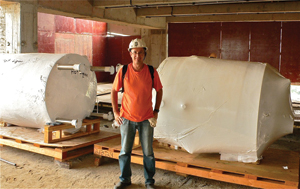New Trends a-Brewing
by Sakamoto Flash
|
Ed Tringali is a brewery guru. He helped three top-notch craft breweries in Japan establish themselves in the 90s. He recently returned for a short trip, when we caught up with him. What did you do during your early tenure in Japan, when the craft beer industry was just starting out? My main responsibility was to commission equipment and get the brewery up and running. Then I provided award-winning recipes and taught the staff as much as I could about brewing quality beers consistently. However, when I first started consulting it was soon apparent that the earlier I was involved in a project–before all the decisions were made–the better it would be for the brewery. In many cases my job getting things running would be easier and the clients money would be spent more wisely. Specifically, when I could give actionable input on the the floor plan, what equipment was purchased and any customization, the client always ended up with a smarter, more user friendly brewery. If you haven’t worked in a brewery, it’s hard to realize the importance of a good sloped floor, proper ventilation and all the different options when choosing equipment. The efficient flow of raw materials, both in and out, is something that must be considered too. What was your background/experience before coming to Japan? I was the brew master of Big Time Brewing Co. in Seattle, a popular and successful brewpub. I also attended several brewing courses at the Siebel Institute and UC Davis. Prior to that I was briefly an assistant at a California brewpub and an avid home brewer. What is the biggest hurdle that the Japanese craft beer market faces from your perspective? I would say profitability, gaining market share and increasing efficiency. I would really like to see the Japanese government reduce the tax rate for small brewers. A two-tier tax rate similar to that in the US where the first 5 million liters are taxed at a much lower rate would go a long way in stimulating the craft beer segment of the industry and have no effect on government coffers. Please tell me a little about rice beers, which are popping up all over Japan. What are the issues with brewing with rice? Brewing with rice remains intriguing for me, particularly if the goal is to add another dimension to a beer by using a small quantity (less than 10%) and not where it is to lessen the cost of the product, as is the case with some industrial lagers being made today (rice is cheaper than malted barley). However, in order to effectively use rice it needs to be boiled to gelatinize the starch and render it readily convertible by the natural enzymes present in a malted barley mash. This would be best accomplished with a dedicated, steam jacketed rice cooker with a mechanical mixer in the brewhouse. However most small brewers using rice get by with boiling it in their kettle, mixing with an oar or paddle and transferring to the mash tun midway through their main malted barley mash. I should point out that if a brewer is interested in using rice they should seek out broken or damaged rice. It’s much more attractively priced than grade A table rice and doesn’t make a bit of difference as it gets liquefied anyway. Brewers also sometimes add rice hulls (husks) to wheat beer mashes where the percentage of wheat is in excess of 50% and they are having difficulty lautering. The rice hulls make the mash bed more permeable and thus easier to lauter. In essence they compensate for the lack of husks in wheat. I’ve always wanted to design and add a rice cooker to one of my projects but haven’t yet had the opportunity. I can think of no better place to do it than Japan. Maybe if I’m fortunate enough to work in Japan again and get involved early enough, it will become a reality. |
エド・トリンガーリさんは、クラフトビア醸造の第一人者です。彼は、90年代に日本で一流クラフトビア醸造所3カ所を設立する手助けをしました。先日、短い旅行に出るために戻ってきた際に、彼に会うことができました。 日本でクラフトビア産業が興ってきた頃、あなたが日本に来て間もなくの頃だと思いますが、当時は何をしていたのですか? 私の主な仕事は醸造設備の初動体制の整えて醸造所を立ち上げることでした。立ち上げが終わったら今度は、受賞レシピを使いながら、高品質のビールを安定的に造ってゆくノウハウを伝授してゆきました。そのような仕事を通して分かったことは、醸造所の立ち上げへの関与は早ければ早いほど良く、色々なことが固まってしまう前にアドバイスをしていった方が後々うまくいく、ということでした。多くの場合、立ち上げの手助けをするという私の仕事は早期であれば早期であるほどスムーズに進み、醸造所側が使う色々な出費も有効に使えるということが分かりました。特に、醸造所の間取りを決める段階から関与出来たような場合は見た目もよく、使い勝手に優れた醸造所が出来上がったと思います。床の一部に傾斜を付けることや、換気の重要性、機種選定にあたって各種オプションを考慮することの重要性などを理解することは実務経験が無いと難しい。これは醸造所の内部と外部両方についていえることですが、原材料の効率的な流れも大変重要な課題です。 来日以前の経歴について教えてください。 シアトルの人気ブルーパブ「ビッグタイム・ブルーイング」で醸造長を務めていました。シーベル醸造科学技術研究所とカリフォルニア大学デービス校でも醸造コースを修了しました。それ以前はカリフォルニアのブルーパブでアシスタントをしたり、自家製ビールに熱心に取り組んでいる人の手伝いをしたりしていました。 日本のクラフトビア市場が抱える最大の問題は何だと思いますか? 採算性、つまりマーケットシェアの獲得と経営の効率化の問題が一番大きいと思います。日本政府には小規模の醸造所に対する税率の引き下げを是非お願いしたい。アメリカでは最初の500万リットルについては税率の大幅な優遇措置が適用されますが、これに似た形の二元的課税を日本でも適用すればビール産業の中でのクラフトビアのシェアを高めることにつながると思います。このような措置は何ら国庫に悪影響を与えるものではありません。 米を原料とするビールが最近日本全国で出てきていますが、米でビールを造る際に重要な点は? 米のビールには以前から関心を寄せています。米のほうが大麦麦芽よりもコストが安いからという理由で大手ビールメーカーがラガータイプのビールの副原料として米を使っていますが、そういったコスト面の理由でなく、米を少量(10%以下)使用することでビールの世界に新たな可能性が生まれるならばこれは意味のあることだと思います。米を有効に使うためには、米を湯に入れてでんぷんを糊化し、さらにマッシュ液に含まれる天然酵素の働きによって糖化させる必要がありますが、この工程は専用のスチームジャケット炊飯釜とメカニカルミキサーがあるとうまくいきます。しかし現実に小規模の醸造所で行われているのは、ケットルで煮沸させ、パドルなどで混和し、糖化槽に移す、といったやり方がほとんどです。また、米を原料として使いたい場合、粉米を探してきて利用することをお勧めします。一等級米よりはるかに安く手に入りますし、結局は液状にしてしまうのですから粉米で全く問題ありません。また、小麦の割合が50%以上のウィートビールの醸造ではろ過が難しくなるので、もみ殻をマッシュ液に加える場合があります。もみ殻を加えることでマッシュ液の浸透性が高まり、ろ過が容易になるのです。小麦に殻が入っていないのでそれをもみ殻で補ってやるわけです。これまで数々の醸造所に関わってきた中で、いつも炊飯釜を醸造設備の一つに加えたいと感じていましたが、残念ながらこれまでそれを実行する機会がありませんでした。そのアイデアを実行するのに日本以上の場所はないと思っています。現在の状況が大きく変わらないうちにもし再び日本で仕事をする機会があれば、今述べたアイデアを是非実行してみようと思っています。 This article is shared content with Japan Beer Times. |









